Succession Planning in Biotech: A Strategic Tool for Future Challenges
VerifiedAdded on 2023/06/05
|13
|2794
|115
AI Summary
This report highlights how successive planning can be used as a strategic tool for Biotech by aligning it to its mission, vision and strategy. It further suggests recommendations that management can use to achieve its needs.
Contribute Materials
Your contribution can guide someone’s learning journey. Share your
documents today.
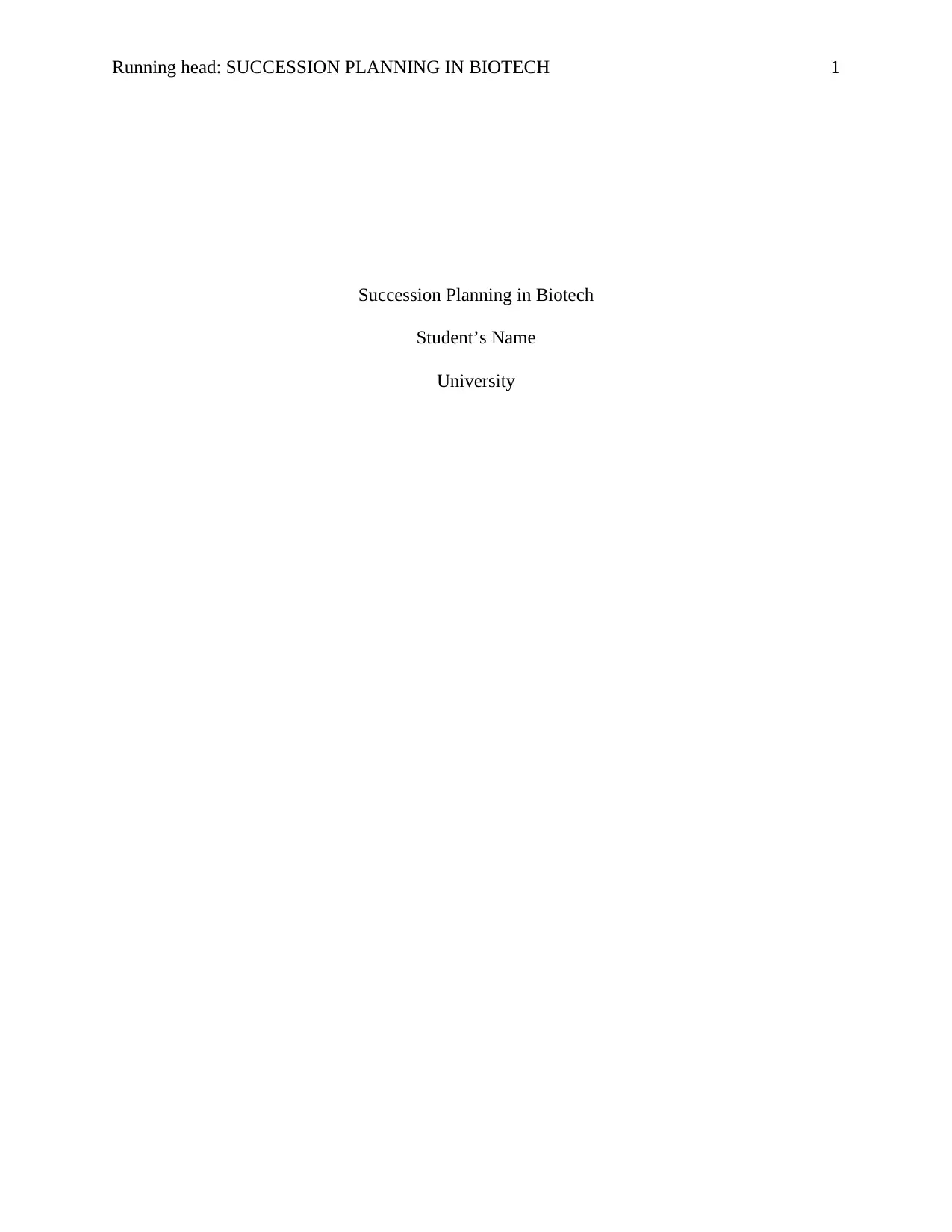
Running head: SUCCESSION PLANNING IN BIOTECH 1
Succession Planning in Biotech
Student’s Name
University
Succession Planning in Biotech
Student’s Name
University
Secure Best Marks with AI Grader
Need help grading? Try our AI Grader for instant feedback on your assignments.
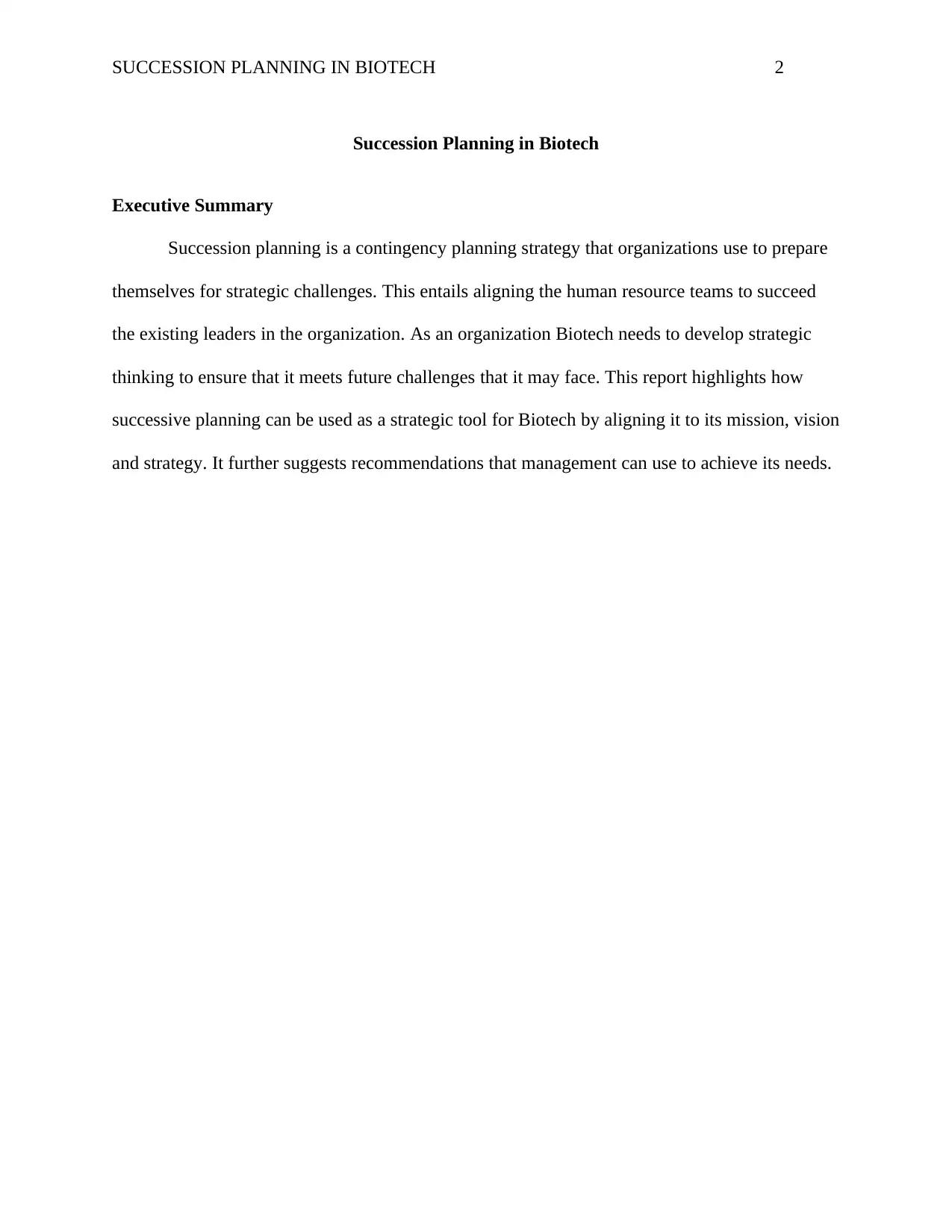
SUCCESSION PLANNING IN BIOTECH 2
Succession Planning in Biotech
Executive Summary
Succession planning is a contingency planning strategy that organizations use to prepare
themselves for strategic challenges. This entails aligning the human resource teams to succeed
the existing leaders in the organization. As an organization Biotech needs to develop strategic
thinking to ensure that it meets future challenges that it may face. This report highlights how
successive planning can be used as a strategic tool for Biotech by aligning it to its mission, vision
and strategy. It further suggests recommendations that management can use to achieve its needs.
Succession Planning in Biotech
Executive Summary
Succession planning is a contingency planning strategy that organizations use to prepare
themselves for strategic challenges. This entails aligning the human resource teams to succeed
the existing leaders in the organization. As an organization Biotech needs to develop strategic
thinking to ensure that it meets future challenges that it may face. This report highlights how
successive planning can be used as a strategic tool for Biotech by aligning it to its mission, vision
and strategy. It further suggests recommendations that management can use to achieve its needs.
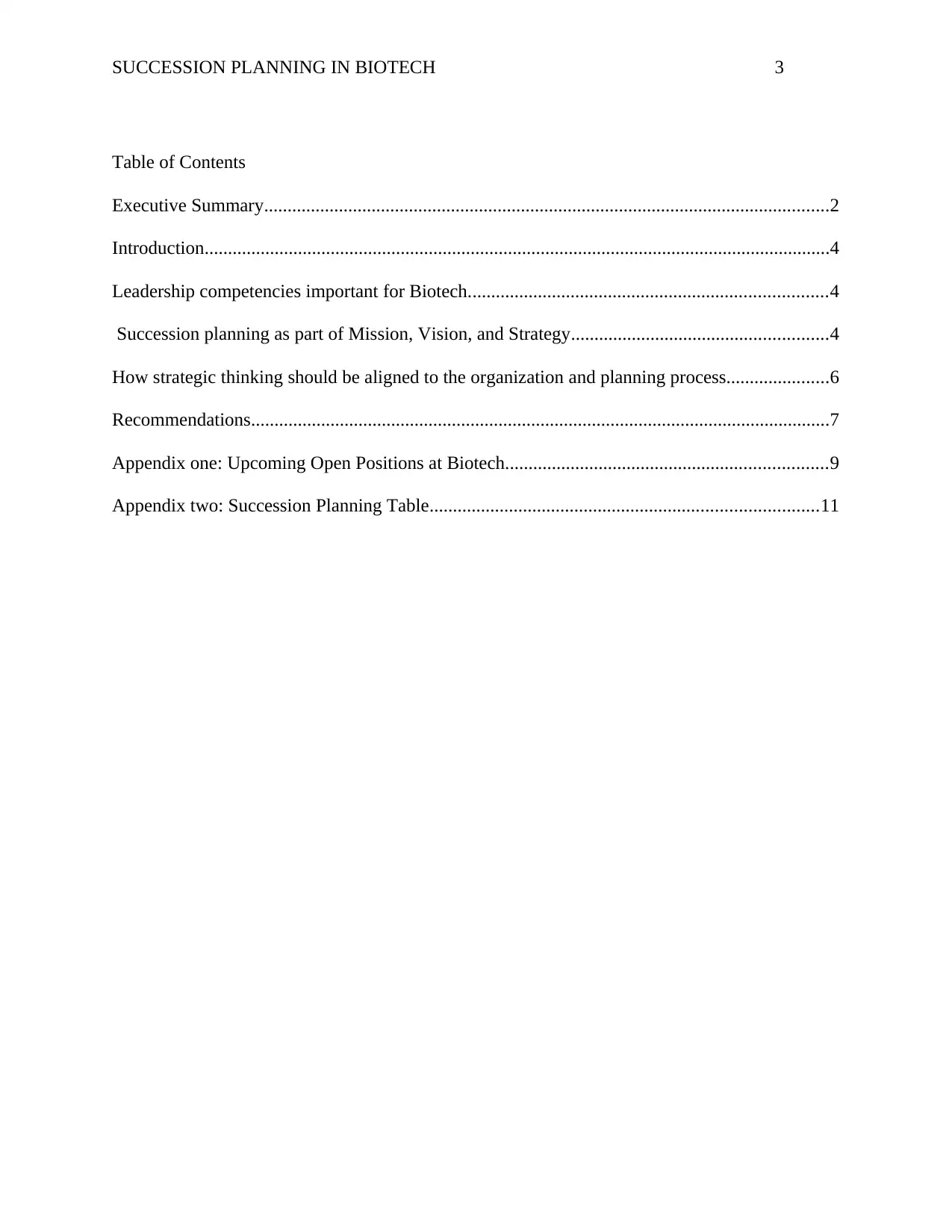
SUCCESSION PLANNING IN BIOTECH 3
Table of Contents
Executive Summary.........................................................................................................................2
Introduction......................................................................................................................................4
Leadership competencies important for Biotech.............................................................................4
Succession planning as part of Mission, Vision, and Strategy.......................................................4
How strategic thinking should be aligned to the organization and planning process......................6
Recommendations............................................................................................................................7
Appendix one: Upcoming Open Positions at Biotech.....................................................................9
Appendix two: Succession Planning Table...................................................................................11
Table of Contents
Executive Summary.........................................................................................................................2
Introduction......................................................................................................................................4
Leadership competencies important for Biotech.............................................................................4
Succession planning as part of Mission, Vision, and Strategy.......................................................4
How strategic thinking should be aligned to the organization and planning process......................6
Recommendations............................................................................................................................7
Appendix one: Upcoming Open Positions at Biotech.....................................................................9
Appendix two: Succession Planning Table...................................................................................11
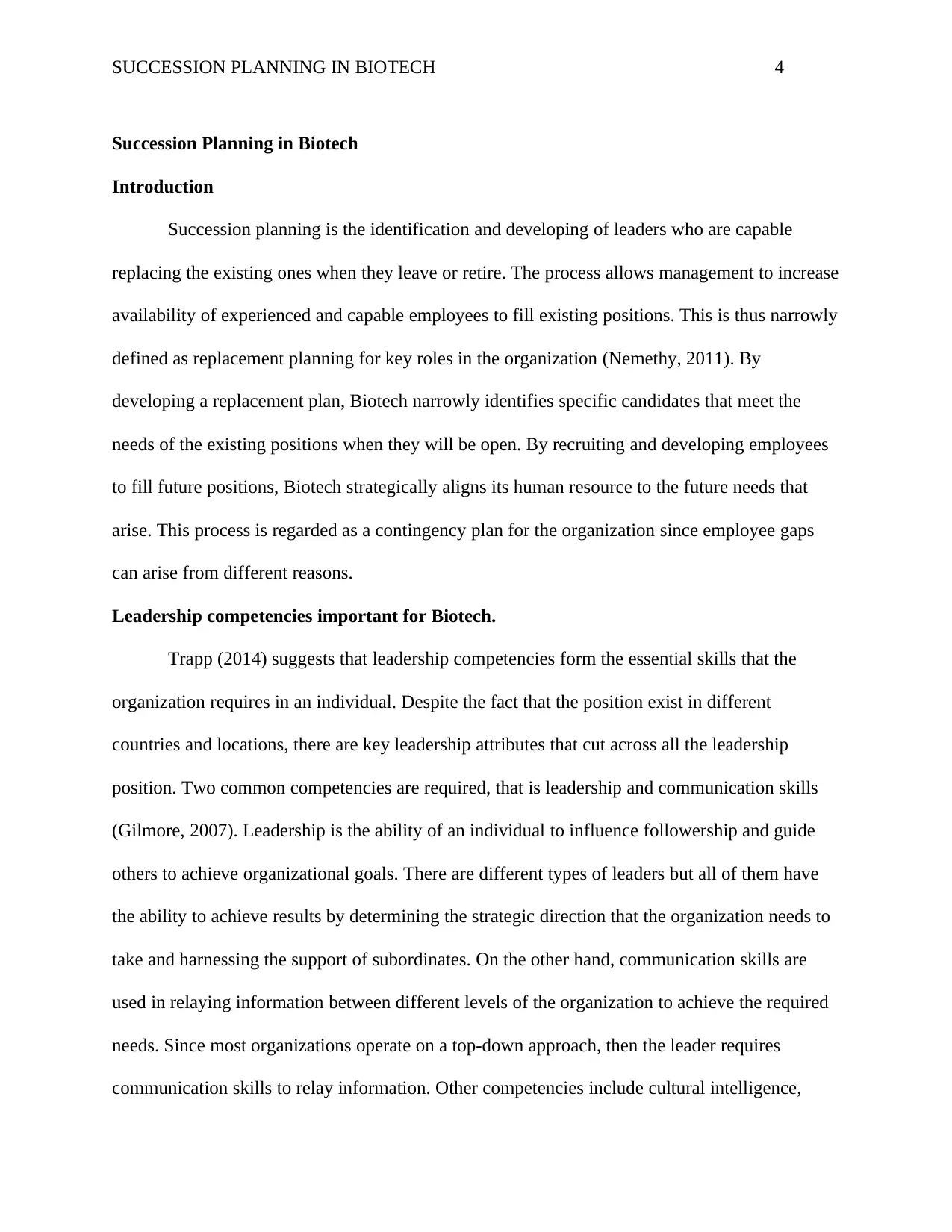
SUCCESSION PLANNING IN BIOTECH 4
Succession Planning in Biotech
Introduction
Succession planning is the identification and developing of leaders who are capable
replacing the existing ones when they leave or retire. The process allows management to increase
availability of experienced and capable employees to fill existing positions. This is thus narrowly
defined as replacement planning for key roles in the organization (Nemethy, 2011). By
developing a replacement plan, Biotech narrowly identifies specific candidates that meet the
needs of the existing positions when they will be open. By recruiting and developing employees
to fill future positions, Biotech strategically aligns its human resource to the future needs that
arise. This process is regarded as a contingency plan for the organization since employee gaps
can arise from different reasons.
Leadership competencies important for Biotech.
Trapp (2014) suggests that leadership competencies form the essential skills that the
organization requires in an individual. Despite the fact that the position exist in different
countries and locations, there are key leadership attributes that cut across all the leadership
position. Two common competencies are required, that is leadership and communication skills
(Gilmore, 2007). Leadership is the ability of an individual to influence followership and guide
others to achieve organizational goals. There are different types of leaders but all of them have
the ability to achieve results by determining the strategic direction that the organization needs to
take and harnessing the support of subordinates. On the other hand, communication skills are
used in relaying information between different levels of the organization to achieve the required
needs. Since most organizations operate on a top-down approach, then the leader requires
communication skills to relay information. Other competencies include cultural intelligence,
Succession Planning in Biotech
Introduction
Succession planning is the identification and developing of leaders who are capable
replacing the existing ones when they leave or retire. The process allows management to increase
availability of experienced and capable employees to fill existing positions. This is thus narrowly
defined as replacement planning for key roles in the organization (Nemethy, 2011). By
developing a replacement plan, Biotech narrowly identifies specific candidates that meet the
needs of the existing positions when they will be open. By recruiting and developing employees
to fill future positions, Biotech strategically aligns its human resource to the future needs that
arise. This process is regarded as a contingency plan for the organization since employee gaps
can arise from different reasons.
Leadership competencies important for Biotech.
Trapp (2014) suggests that leadership competencies form the essential skills that the
organization requires in an individual. Despite the fact that the position exist in different
countries and locations, there are key leadership attributes that cut across all the leadership
position. Two common competencies are required, that is leadership and communication skills
(Gilmore, 2007). Leadership is the ability of an individual to influence followership and guide
others to achieve organizational goals. There are different types of leaders but all of them have
the ability to achieve results by determining the strategic direction that the organization needs to
take and harnessing the support of subordinates. On the other hand, communication skills are
used in relaying information between different levels of the organization to achieve the required
needs. Since most organizations operate on a top-down approach, then the leader requires
communication skills to relay information. Other competencies include cultural intelligence,
Secure Best Marks with AI Grader
Need help grading? Try our AI Grader for instant feedback on your assignments.
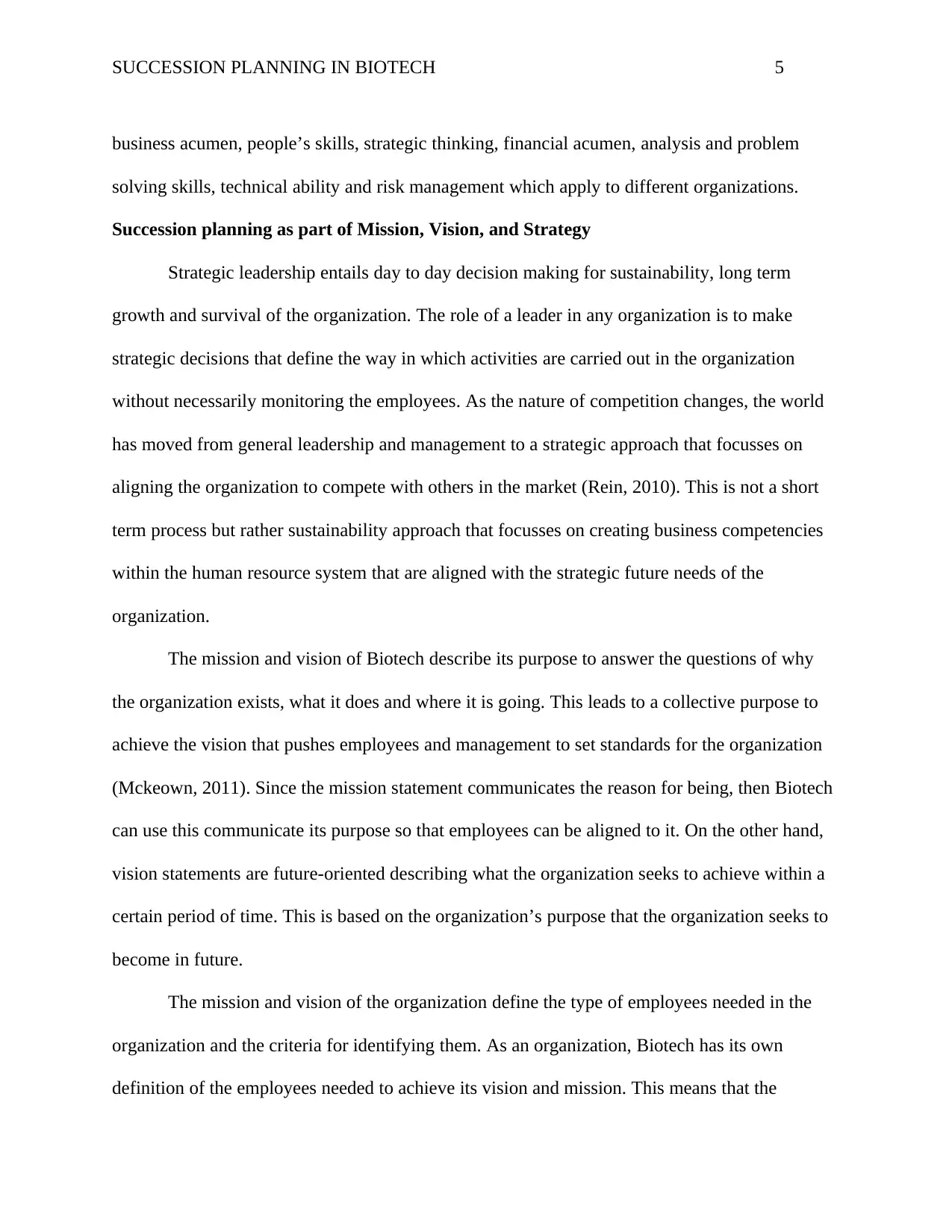
SUCCESSION PLANNING IN BIOTECH 5
business acumen, people’s skills, strategic thinking, financial acumen, analysis and problem
solving skills, technical ability and risk management which apply to different organizations.
Succession planning as part of Mission, Vision, and Strategy
Strategic leadership entails day to day decision making for sustainability, long term
growth and survival of the organization. The role of a leader in any organization is to make
strategic decisions that define the way in which activities are carried out in the organization
without necessarily monitoring the employees. As the nature of competition changes, the world
has moved from general leadership and management to a strategic approach that focusses on
aligning the organization to compete with others in the market (Rein, 2010). This is not a short
term process but rather sustainability approach that focusses on creating business competencies
within the human resource system that are aligned with the strategic future needs of the
organization.
The mission and vision of Biotech describe its purpose to answer the questions of why
the organization exists, what it does and where it is going. This leads to a collective purpose to
achieve the vision that pushes employees and management to set standards for the organization
(Mckeown, 2011). Since the mission statement communicates the reason for being, then Biotech
can use this communicate its purpose so that employees can be aligned to it. On the other hand,
vision statements are future-oriented describing what the organization seeks to achieve within a
certain period of time. This is based on the organization’s purpose that the organization seeks to
become in future.
The mission and vision of the organization define the type of employees needed in the
organization and the criteria for identifying them. As an organization, Biotech has its own
definition of the employees needed to achieve its vision and mission. This means that the
business acumen, people’s skills, strategic thinking, financial acumen, analysis and problem
solving skills, technical ability and risk management which apply to different organizations.
Succession planning as part of Mission, Vision, and Strategy
Strategic leadership entails day to day decision making for sustainability, long term
growth and survival of the organization. The role of a leader in any organization is to make
strategic decisions that define the way in which activities are carried out in the organization
without necessarily monitoring the employees. As the nature of competition changes, the world
has moved from general leadership and management to a strategic approach that focusses on
aligning the organization to compete with others in the market (Rein, 2010). This is not a short
term process but rather sustainability approach that focusses on creating business competencies
within the human resource system that are aligned with the strategic future needs of the
organization.
The mission and vision of Biotech describe its purpose to answer the questions of why
the organization exists, what it does and where it is going. This leads to a collective purpose to
achieve the vision that pushes employees and management to set standards for the organization
(Mckeown, 2011). Since the mission statement communicates the reason for being, then Biotech
can use this communicate its purpose so that employees can be aligned to it. On the other hand,
vision statements are future-oriented describing what the organization seeks to achieve within a
certain period of time. This is based on the organization’s purpose that the organization seeks to
become in future.
The mission and vision of the organization define the type of employees needed in the
organization and the criteria for identifying them. As an organization, Biotech has its own
definition of the employees needed to achieve its vision and mission. This means that the
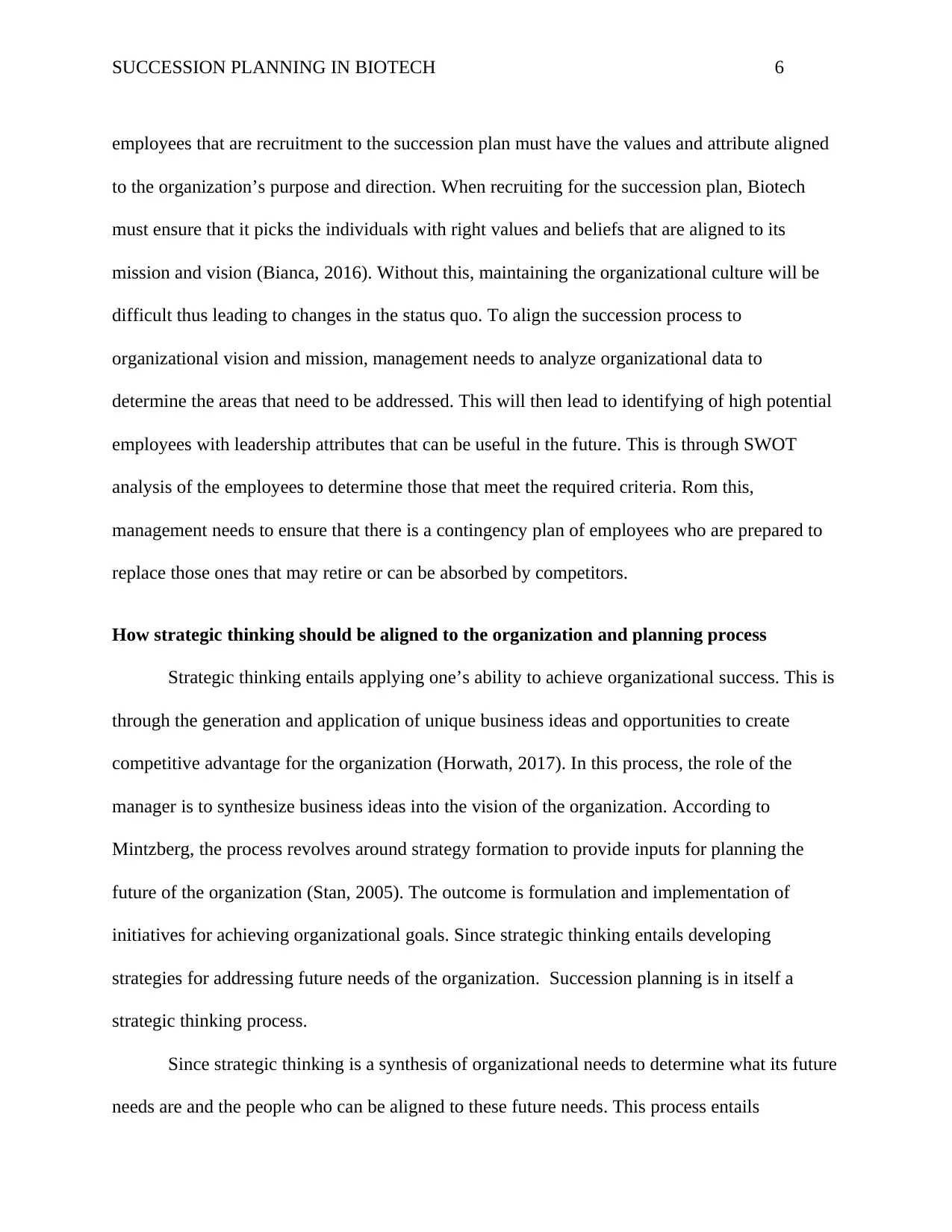
SUCCESSION PLANNING IN BIOTECH 6
employees that are recruitment to the succession plan must have the values and attribute aligned
to the organization’s purpose and direction. When recruiting for the succession plan, Biotech
must ensure that it picks the individuals with right values and beliefs that are aligned to its
mission and vision (Bianca, 2016). Without this, maintaining the organizational culture will be
difficult thus leading to changes in the status quo. To align the succession process to
organizational vision and mission, management needs to analyze organizational data to
determine the areas that need to be addressed. This will then lead to identifying of high potential
employees with leadership attributes that can be useful in the future. This is through SWOT
analysis of the employees to determine those that meet the required criteria. Rom this,
management needs to ensure that there is a contingency plan of employees who are prepared to
replace those ones that may retire or can be absorbed by competitors.
How strategic thinking should be aligned to the organization and planning process
Strategic thinking entails applying one’s ability to achieve organizational success. This is
through the generation and application of unique business ideas and opportunities to create
competitive advantage for the organization (Horwath, 2017). In this process, the role of the
manager is to synthesize business ideas into the vision of the organization. According to
Mintzberg, the process revolves around strategy formation to provide inputs for planning the
future of the organization (Stan, 2005). The outcome is formulation and implementation of
initiatives for achieving organizational goals. Since strategic thinking entails developing
strategies for addressing future needs of the organization. Succession planning is in itself a
strategic thinking process.
Since strategic thinking is a synthesis of organizational needs to determine what its future
needs are and the people who can be aligned to these future needs. This process entails
employees that are recruitment to the succession plan must have the values and attribute aligned
to the organization’s purpose and direction. When recruiting for the succession plan, Biotech
must ensure that it picks the individuals with right values and beliefs that are aligned to its
mission and vision (Bianca, 2016). Without this, maintaining the organizational culture will be
difficult thus leading to changes in the status quo. To align the succession process to
organizational vision and mission, management needs to analyze organizational data to
determine the areas that need to be addressed. This will then lead to identifying of high potential
employees with leadership attributes that can be useful in the future. This is through SWOT
analysis of the employees to determine those that meet the required criteria. Rom this,
management needs to ensure that there is a contingency plan of employees who are prepared to
replace those ones that may retire or can be absorbed by competitors.
How strategic thinking should be aligned to the organization and planning process
Strategic thinking entails applying one’s ability to achieve organizational success. This is
through the generation and application of unique business ideas and opportunities to create
competitive advantage for the organization (Horwath, 2017). In this process, the role of the
manager is to synthesize business ideas into the vision of the organization. According to
Mintzberg, the process revolves around strategy formation to provide inputs for planning the
future of the organization (Stan, 2005). The outcome is formulation and implementation of
initiatives for achieving organizational goals. Since strategic thinking entails developing
strategies for addressing future needs of the organization. Succession planning is in itself a
strategic thinking process.
Since strategic thinking is a synthesis of organizational needs to determine what its future
needs are and the people who can be aligned to these future needs. This process entails
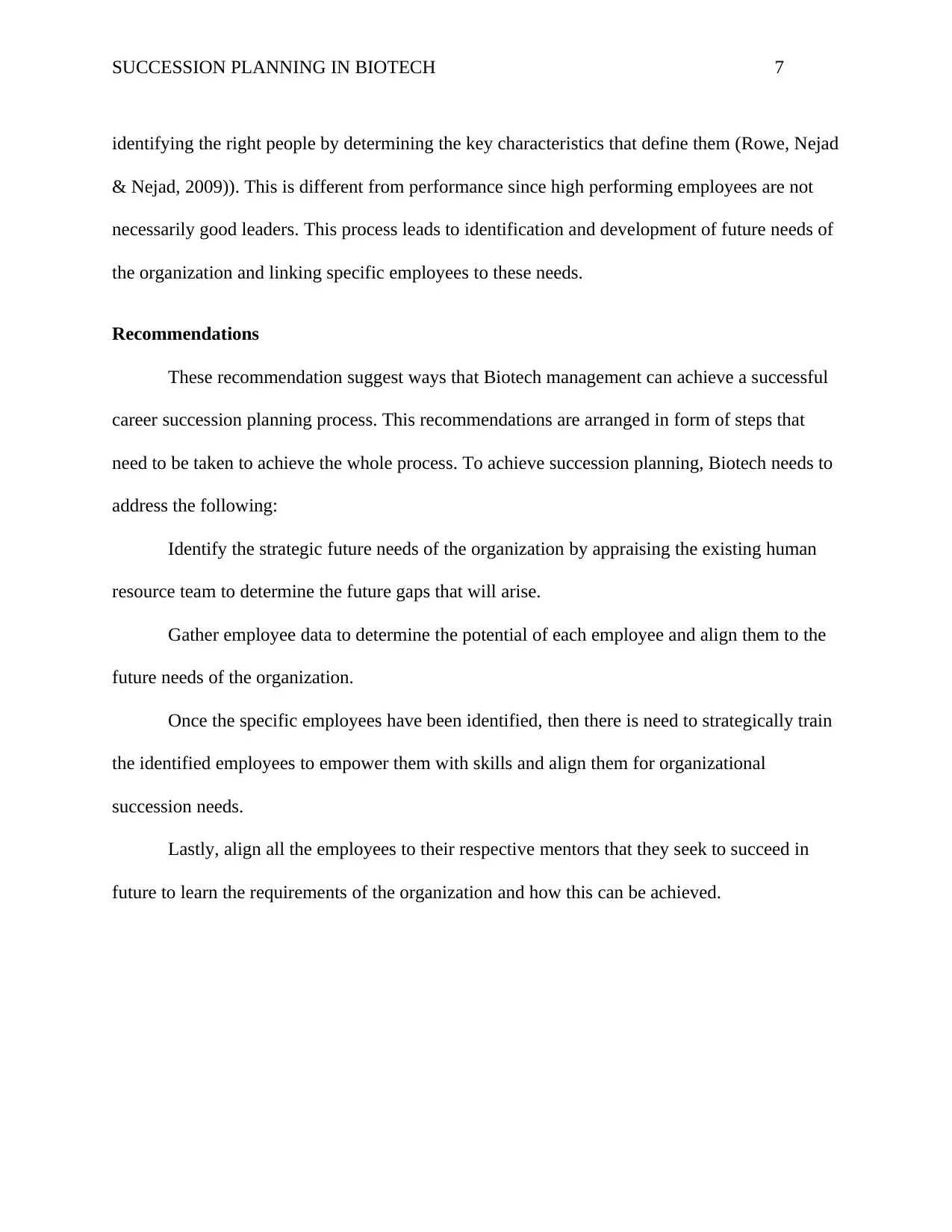
SUCCESSION PLANNING IN BIOTECH 7
identifying the right people by determining the key characteristics that define them (Rowe, Nejad
& Nejad, 2009)). This is different from performance since high performing employees are not
necessarily good leaders. This process leads to identification and development of future needs of
the organization and linking specific employees to these needs.
Recommendations
These recommendation suggest ways that Biotech management can achieve a successful
career succession planning process. This recommendations are arranged in form of steps that
need to be taken to achieve the whole process. To achieve succession planning, Biotech needs to
address the following:
Identify the strategic future needs of the organization by appraising the existing human
resource team to determine the future gaps that will arise.
Gather employee data to determine the potential of each employee and align them to the
future needs of the organization.
Once the specific employees have been identified, then there is need to strategically train
the identified employees to empower them with skills and align them for organizational
succession needs.
Lastly, align all the employees to their respective mentors that they seek to succeed in
future to learn the requirements of the organization and how this can be achieved.
identifying the right people by determining the key characteristics that define them (Rowe, Nejad
& Nejad, 2009)). This is different from performance since high performing employees are not
necessarily good leaders. This process leads to identification and development of future needs of
the organization and linking specific employees to these needs.
Recommendations
These recommendation suggest ways that Biotech management can achieve a successful
career succession planning process. This recommendations are arranged in form of steps that
need to be taken to achieve the whole process. To achieve succession planning, Biotech needs to
address the following:
Identify the strategic future needs of the organization by appraising the existing human
resource team to determine the future gaps that will arise.
Gather employee data to determine the potential of each employee and align them to the
future needs of the organization.
Once the specific employees have been identified, then there is need to strategically train
the identified employees to empower them with skills and align them for organizational
succession needs.
Lastly, align all the employees to their respective mentors that they seek to succeed in
future to learn the requirements of the organization and how this can be achieved.
Paraphrase This Document
Need a fresh take? Get an instant paraphrase of this document with our AI Paraphraser
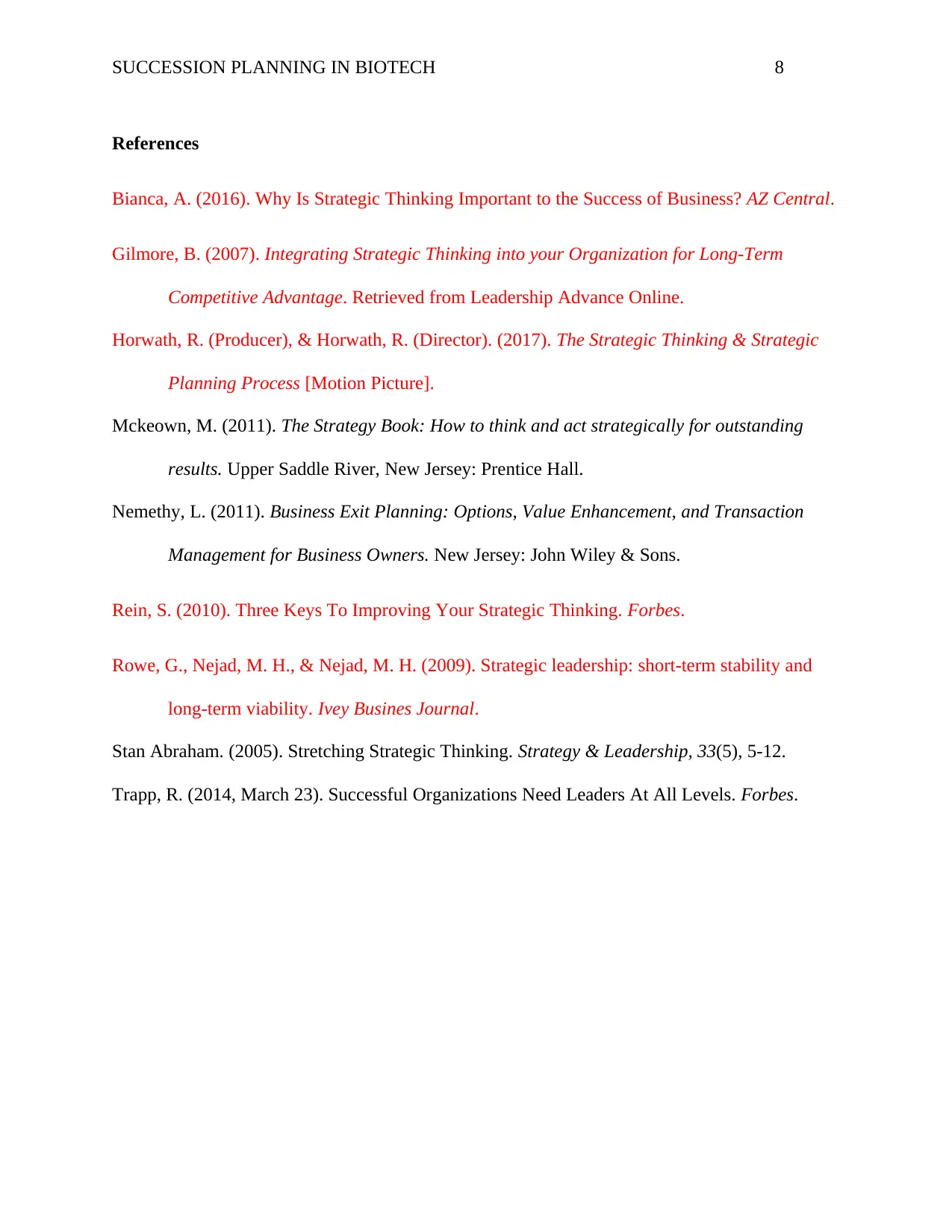
SUCCESSION PLANNING IN BIOTECH 8
References
Bianca, A. (2016). Why Is Strategic Thinking Important to the Success of Business? AZ Central.
Gilmore, B. (2007). Integrating Strategic Thinking into your Organization for Long-Term
Competitive Advantage. Retrieved from Leadership Advance Online.
Horwath, R. (Producer), & Horwath, R. (Director). (2017). The Strategic Thinking & Strategic
Planning Process [Motion Picture].
Mckeown, M. (2011). The Strategy Book: How to think and act strategically for outstanding
results. Upper Saddle River, New Jersey: Prentice Hall.
Nemethy, L. (2011). Business Exit Planning: Options, Value Enhancement, and Transaction
Management for Business Owners. New Jersey: John Wiley & Sons.
Rein, S. (2010). Three Keys To Improving Your Strategic Thinking. Forbes.
Rowe, G., Nejad, M. H., & Nejad, M. H. (2009). Strategic leadership: short-term stability and
long-term viability. Ivey Busines Journal.
Stan Abraham. (2005). Stretching Strategic Thinking. Strategy & Leadership, 33(5), 5-12.
Trapp, R. (2014, March 23). Successful Organizations Need Leaders At All Levels. Forbes.
References
Bianca, A. (2016). Why Is Strategic Thinking Important to the Success of Business? AZ Central.
Gilmore, B. (2007). Integrating Strategic Thinking into your Organization for Long-Term
Competitive Advantage. Retrieved from Leadership Advance Online.
Horwath, R. (Producer), & Horwath, R. (Director). (2017). The Strategic Thinking & Strategic
Planning Process [Motion Picture].
Mckeown, M. (2011). The Strategy Book: How to think and act strategically for outstanding
results. Upper Saddle River, New Jersey: Prentice Hall.
Nemethy, L. (2011). Business Exit Planning: Options, Value Enhancement, and Transaction
Management for Business Owners. New Jersey: John Wiley & Sons.
Rein, S. (2010). Three Keys To Improving Your Strategic Thinking. Forbes.
Rowe, G., Nejad, M. H., & Nejad, M. H. (2009). Strategic leadership: short-term stability and
long-term viability. Ivey Busines Journal.
Stan Abraham. (2005). Stretching Strategic Thinking. Strategy & Leadership, 33(5), 5-12.
Trapp, R. (2014, March 23). Successful Organizations Need Leaders At All Levels. Forbes.
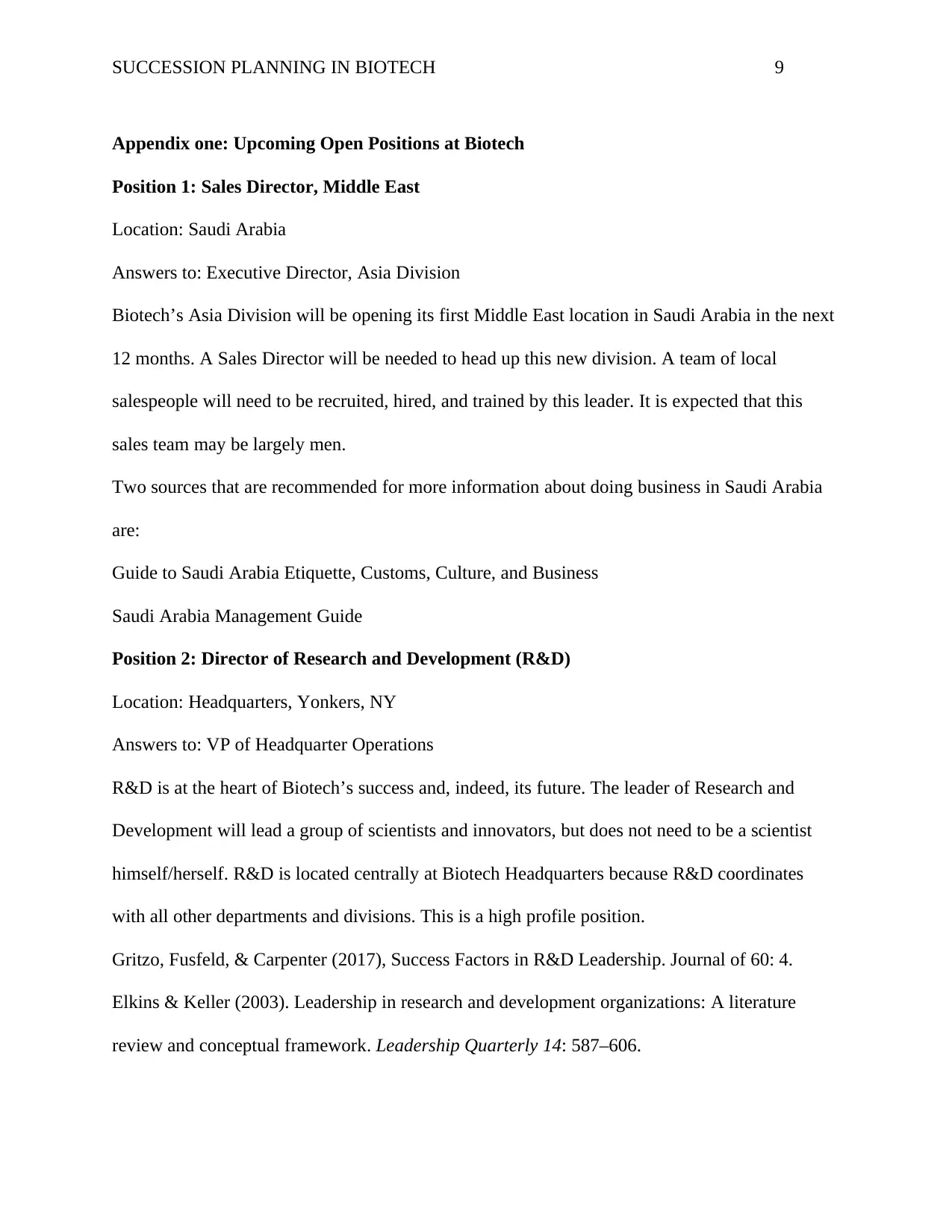
SUCCESSION PLANNING IN BIOTECH 9
Appendix one: Upcoming Open Positions at Biotech
Position 1: Sales Director, Middle East
Location: Saudi Arabia
Answers to: Executive Director, Asia Division
Biotech’s Asia Division will be opening its first Middle East location in Saudi Arabia in the next
12 months. A Sales Director will be needed to head up this new division. A team of local
salespeople will need to be recruited, hired, and trained by this leader. It is expected that this
sales team may be largely men.
Two sources that are recommended for more information about doing business in Saudi Arabia
are:
Guide to Saudi Arabia Etiquette, Customs, Culture, and Business
Saudi Arabia Management Guide
Position 2: Director of Research and Development (R&D)
Location: Headquarters, Yonkers, NY
Answers to: VP of Headquarter Operations
R&D is at the heart of Biotech’s success and, indeed, its future. The leader of Research and
Development will lead a group of scientists and innovators, but does not need to be a scientist
himself/herself. R&D is located centrally at Biotech Headquarters because R&D coordinates
with all other departments and divisions. This is a high profile position.
Gritzo, Fusfeld, & Carpenter (2017), Success Factors in R&D Leadership. Journal of 60: 4.
Elkins & Keller (2003). Leadership in research and development organizations: A literature
review and conceptual framework. Leadership Quarterly 14: 587–606.
Appendix one: Upcoming Open Positions at Biotech
Position 1: Sales Director, Middle East
Location: Saudi Arabia
Answers to: Executive Director, Asia Division
Biotech’s Asia Division will be opening its first Middle East location in Saudi Arabia in the next
12 months. A Sales Director will be needed to head up this new division. A team of local
salespeople will need to be recruited, hired, and trained by this leader. It is expected that this
sales team may be largely men.
Two sources that are recommended for more information about doing business in Saudi Arabia
are:
Guide to Saudi Arabia Etiquette, Customs, Culture, and Business
Saudi Arabia Management Guide
Position 2: Director of Research and Development (R&D)
Location: Headquarters, Yonkers, NY
Answers to: VP of Headquarter Operations
R&D is at the heart of Biotech’s success and, indeed, its future. The leader of Research and
Development will lead a group of scientists and innovators, but does not need to be a scientist
himself/herself. R&D is located centrally at Biotech Headquarters because R&D coordinates
with all other departments and divisions. This is a high profile position.
Gritzo, Fusfeld, & Carpenter (2017), Success Factors in R&D Leadership. Journal of 60: 4.
Elkins & Keller (2003). Leadership in research and development organizations: A literature
review and conceptual framework. Leadership Quarterly 14: 587–606.
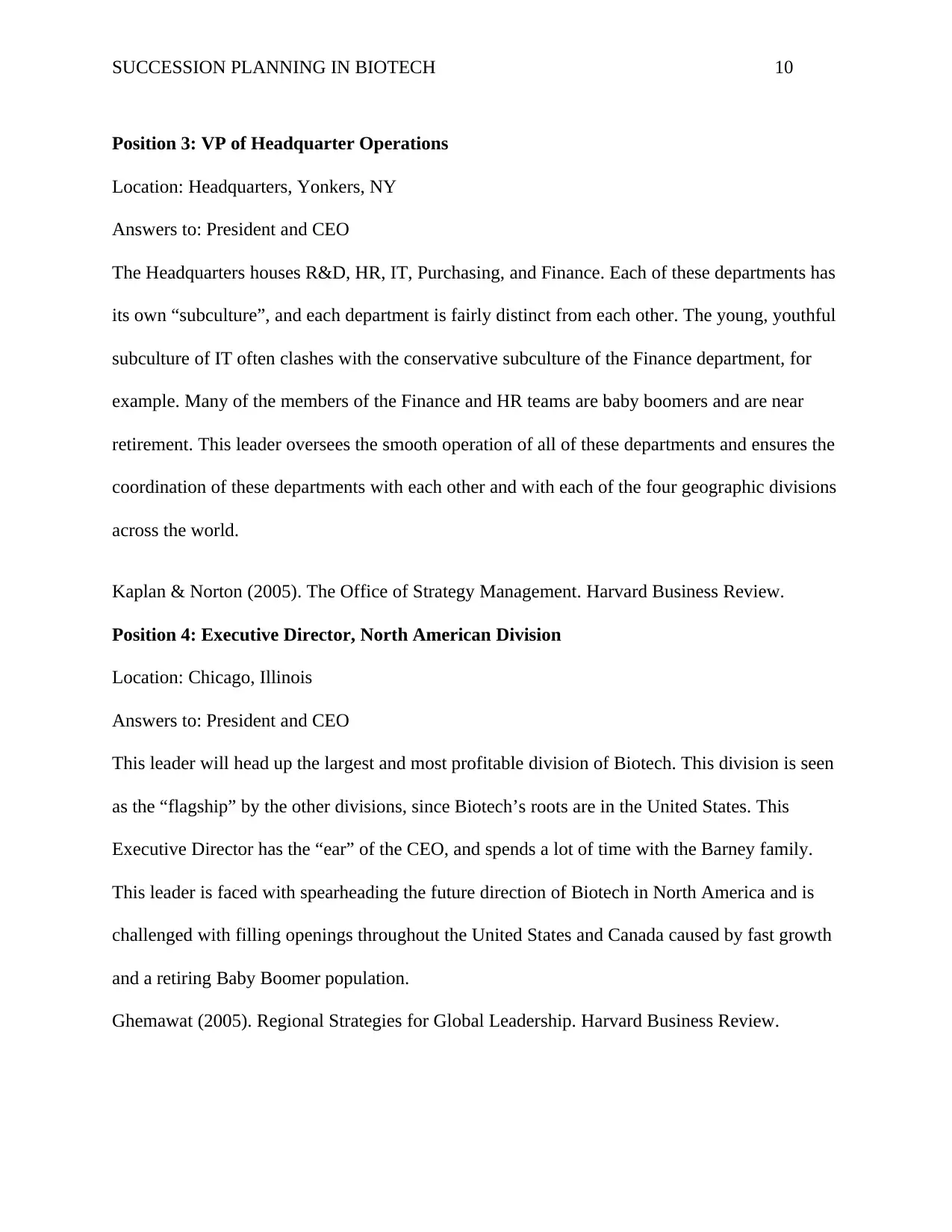
SUCCESSION PLANNING IN BIOTECH 10
Position 3: VP of Headquarter Operations
Location: Headquarters, Yonkers, NY
Answers to: President and CEO
The Headquarters houses R&D, HR, IT, Purchasing, and Finance. Each of these departments has
its own “subculture”, and each department is fairly distinct from each other. The young, youthful
subculture of IT often clashes with the conservative subculture of the Finance department, for
example. Many of the members of the Finance and HR teams are baby boomers and are near
retirement. This leader oversees the smooth operation of all of these departments and ensures the
coordination of these departments with each other and with each of the four geographic divisions
across the world.
Kaplan & Norton (2005). The Office of Strategy Management. Harvard Business Review.
Position 4: Executive Director, North American Division
Location: Chicago, Illinois
Answers to: President and CEO
This leader will head up the largest and most profitable division of Biotech. This division is seen
as the “flagship” by the other divisions, since Biotech’s roots are in the United States. This
Executive Director has the “ear” of the CEO, and spends a lot of time with the Barney family.
This leader is faced with spearheading the future direction of Biotech in North America and is
challenged with filling openings throughout the United States and Canada caused by fast growth
and a retiring Baby Boomer population.
Ghemawat (2005). Regional Strategies for Global Leadership. Harvard Business Review.
Position 3: VP of Headquarter Operations
Location: Headquarters, Yonkers, NY
Answers to: President and CEO
The Headquarters houses R&D, HR, IT, Purchasing, and Finance. Each of these departments has
its own “subculture”, and each department is fairly distinct from each other. The young, youthful
subculture of IT often clashes with the conservative subculture of the Finance department, for
example. Many of the members of the Finance and HR teams are baby boomers and are near
retirement. This leader oversees the smooth operation of all of these departments and ensures the
coordination of these departments with each other and with each of the four geographic divisions
across the world.
Kaplan & Norton (2005). The Office of Strategy Management. Harvard Business Review.
Position 4: Executive Director, North American Division
Location: Chicago, Illinois
Answers to: President and CEO
This leader will head up the largest and most profitable division of Biotech. This division is seen
as the “flagship” by the other divisions, since Biotech’s roots are in the United States. This
Executive Director has the “ear” of the CEO, and spends a lot of time with the Barney family.
This leader is faced with spearheading the future direction of Biotech in North America and is
challenged with filling openings throughout the United States and Canada caused by fast growth
and a retiring Baby Boomer population.
Ghemawat (2005). Regional Strategies for Global Leadership. Harvard Business Review.
Secure Best Marks with AI Grader
Need help grading? Try our AI Grader for instant feedback on your assignments.
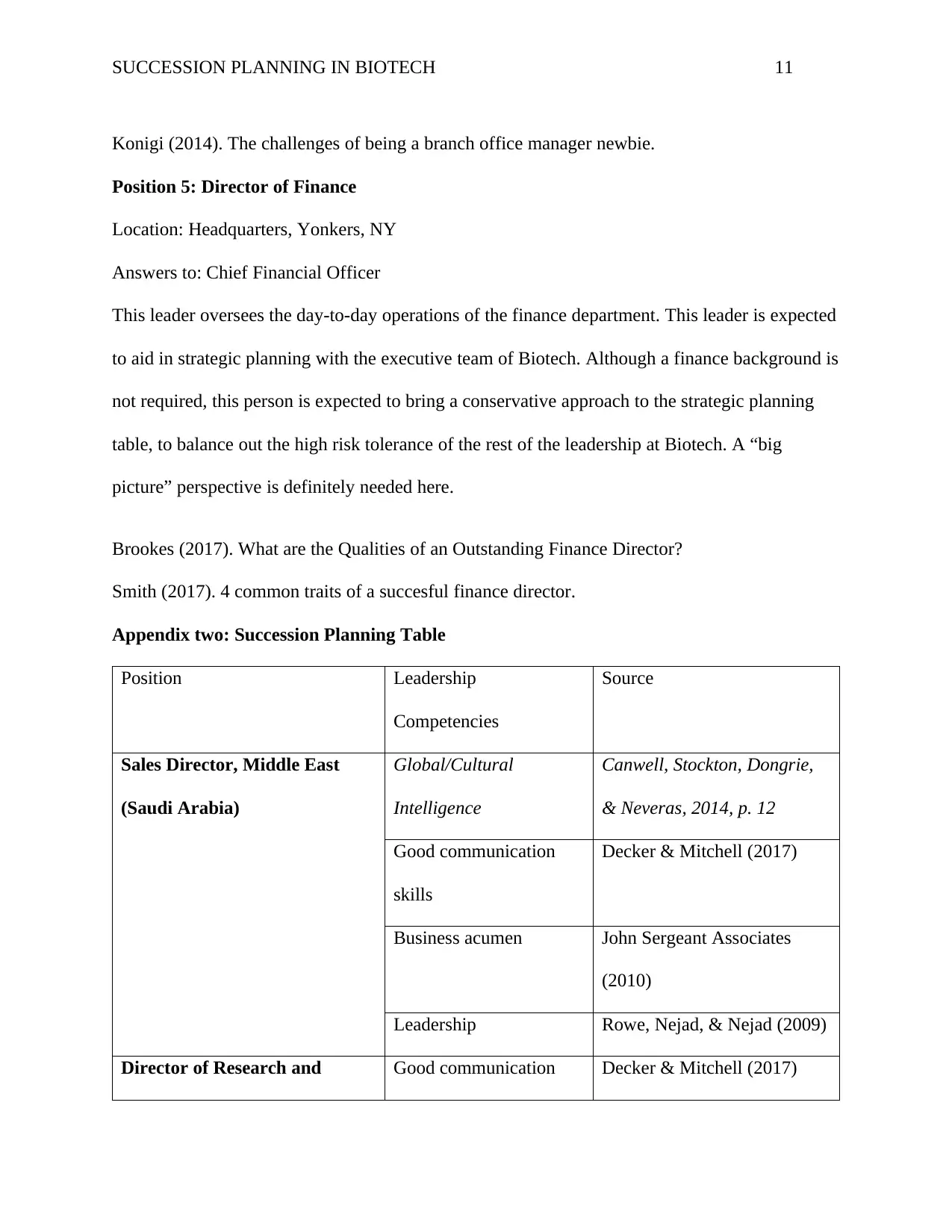
SUCCESSION PLANNING IN BIOTECH 11
Konigi (2014). The challenges of being a branch office manager newbie.
Position 5: Director of Finance
Location: Headquarters, Yonkers, NY
Answers to: Chief Financial Officer
This leader oversees the day-to-day operations of the finance department. This leader is expected
to aid in strategic planning with the executive team of Biotech. Although a finance background is
not required, this person is expected to bring a conservative approach to the strategic planning
table, to balance out the high risk tolerance of the rest of the leadership at Biotech. A “big
picture” perspective is definitely needed here.
Brookes (2017). What are the Qualities of an Outstanding Finance Director?
Smith (2017). 4 common traits of a succesful finance director.
Appendix two: Succession Planning Table
Position Leadership
Competencies
Source
Sales Director, Middle East
(Saudi Arabia)
Global/Cultural
Intelligence
Canwell, Stockton, Dongrie,
& Neveras, 2014, p. 12
Good communication
skills
Decker & Mitchell (2017)
Business acumen John Sergeant Associates
(2010)
Leadership Rowe, Nejad, & Nejad (2009)
Director of Research and Good communication Decker & Mitchell (2017)
Konigi (2014). The challenges of being a branch office manager newbie.
Position 5: Director of Finance
Location: Headquarters, Yonkers, NY
Answers to: Chief Financial Officer
This leader oversees the day-to-day operations of the finance department. This leader is expected
to aid in strategic planning with the executive team of Biotech. Although a finance background is
not required, this person is expected to bring a conservative approach to the strategic planning
table, to balance out the high risk tolerance of the rest of the leadership at Biotech. A “big
picture” perspective is definitely needed here.
Brookes (2017). What are the Qualities of an Outstanding Finance Director?
Smith (2017). 4 common traits of a succesful finance director.
Appendix two: Succession Planning Table
Position Leadership
Competencies
Source
Sales Director, Middle East
(Saudi Arabia)
Global/Cultural
Intelligence
Canwell, Stockton, Dongrie,
& Neveras, 2014, p. 12
Good communication
skills
Decker & Mitchell (2017)
Business acumen John Sergeant Associates
(2010)
Leadership Rowe, Nejad, & Nejad (2009)
Director of Research and Good communication Decker & Mitchell (2017)
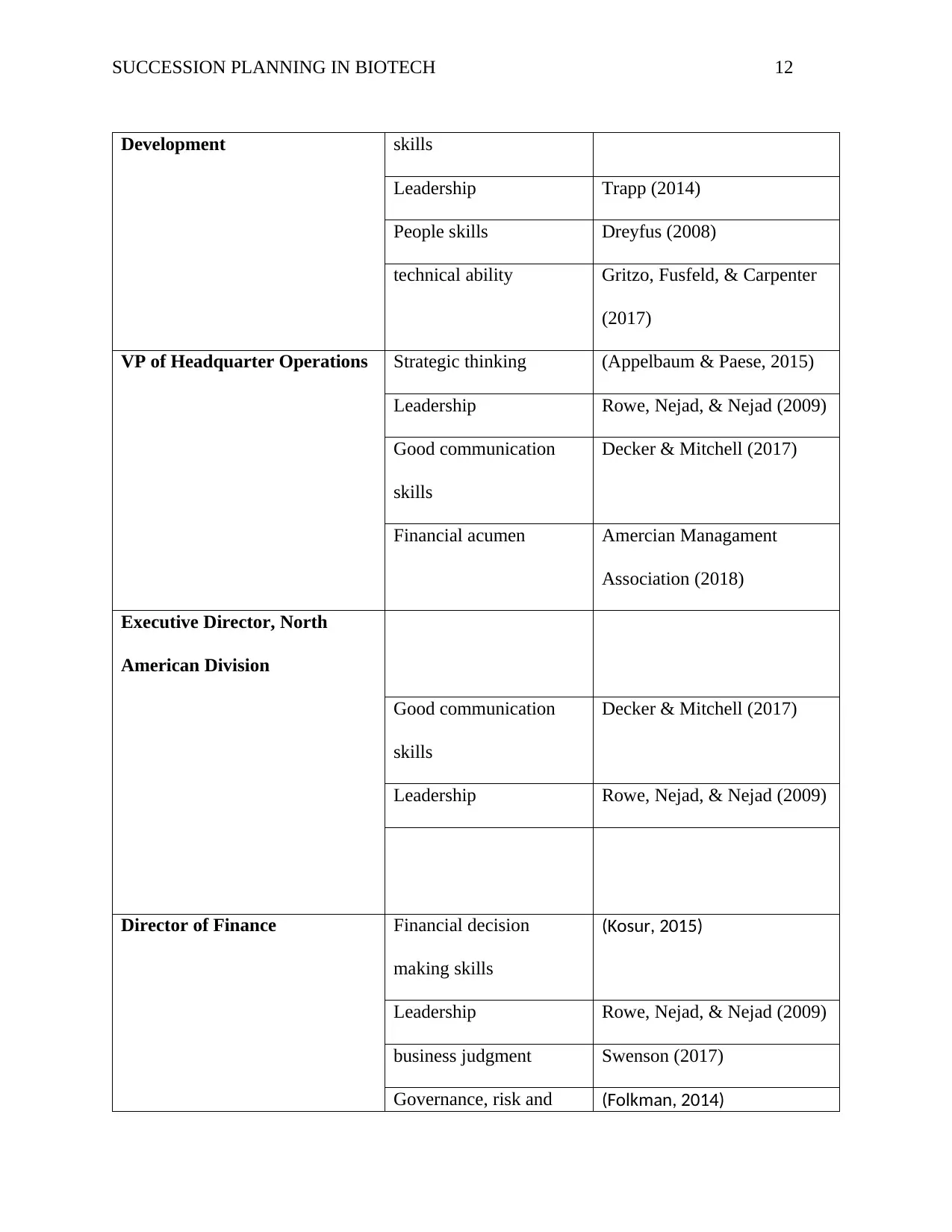
SUCCESSION PLANNING IN BIOTECH 12
Development skills
Leadership Trapp (2014)
People skills Dreyfus (2008)
technical ability Gritzo, Fusfeld, & Carpenter
(2017)
VP of Headquarter Operations Strategic thinking (Appelbaum & Paese, 2015)
Leadership Rowe, Nejad, & Nejad (2009)
Good communication
skills
Decker & Mitchell (2017)
Financial acumen Amercian Managament
Association (2018)
Executive Director, North
American Division
Good communication
skills
Decker & Mitchell (2017)
Leadership Rowe, Nejad, & Nejad (2009)
Director of Finance Financial decision
making skills
(Kosur, 2015)
Leadership Rowe, Nejad, & Nejad (2009)
business judgment Swenson (2017)
Governance, risk and (Folkman, 2014)
Development skills
Leadership Trapp (2014)
People skills Dreyfus (2008)
technical ability Gritzo, Fusfeld, & Carpenter
(2017)
VP of Headquarter Operations Strategic thinking (Appelbaum & Paese, 2015)
Leadership Rowe, Nejad, & Nejad (2009)
Good communication
skills
Decker & Mitchell (2017)
Financial acumen Amercian Managament
Association (2018)
Executive Director, North
American Division
Good communication
skills
Decker & Mitchell (2017)
Leadership Rowe, Nejad, & Nejad (2009)
Director of Finance Financial decision
making skills
(Kosur, 2015)
Leadership Rowe, Nejad, & Nejad (2009)
business judgment Swenson (2017)
Governance, risk and (Folkman, 2014)
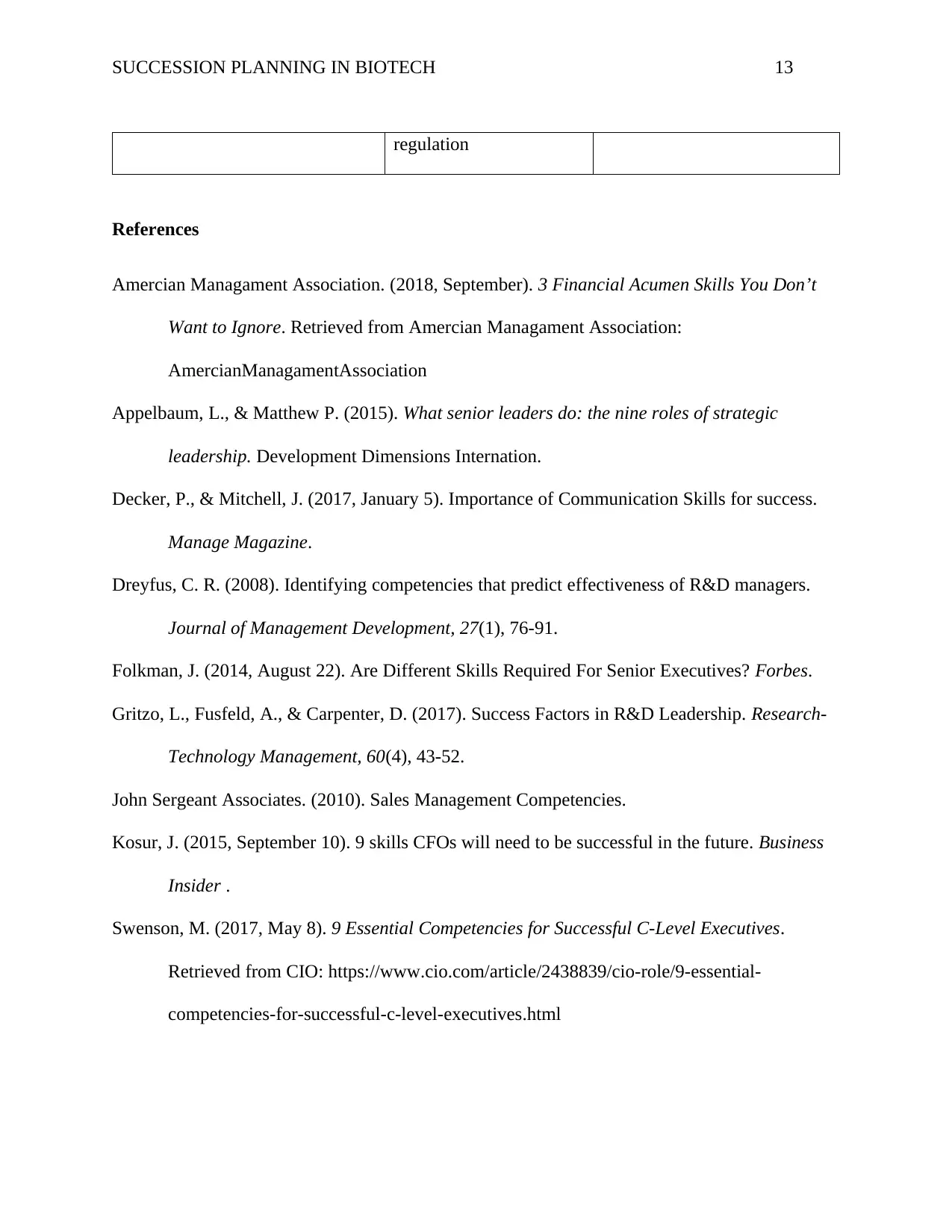
SUCCESSION PLANNING IN BIOTECH 13
regulation
References
Amercian Managament Association. (2018, September). 3 Financial Acumen Skills You Don’t
Want to Ignore. Retrieved from Amercian Managament Association:
AmercianManagamentAssociation
Appelbaum, L., & Matthew P. (2015). What senior leaders do: the nine roles of strategic
leadership. Development Dimensions Internation.
Decker, P., & Mitchell, J. (2017, January 5). Importance of Communication Skills for success.
Manage Magazine.
Dreyfus, C. R. (2008). Identifying competencies that predict effectiveness of R&D managers.
Journal of Management Development, 27(1), 76-91.
Folkman, J. (2014, August 22). Are Different Skills Required For Senior Executives? Forbes.
Gritzo, L., Fusfeld, A., & Carpenter, D. (2017). Success Factors in R&D Leadership. Research-
Technology Management, 60(4), 43-52.
John Sergeant Associates. (2010). Sales Management Competencies.
Kosur, J. (2015, September 10). 9 skills CFOs will need to be successful in the future. Business
Insider .
Swenson, M. (2017, May 8). 9 Essential Competencies for Successful C-Level Executives.
Retrieved from CIO: https://www.cio.com/article/2438839/cio-role/9-essential-
competencies-for-successful-c-level-executives.html
regulation
References
Amercian Managament Association. (2018, September). 3 Financial Acumen Skills You Don’t
Want to Ignore. Retrieved from Amercian Managament Association:
AmercianManagamentAssociation
Appelbaum, L., & Matthew P. (2015). What senior leaders do: the nine roles of strategic
leadership. Development Dimensions Internation.
Decker, P., & Mitchell, J. (2017, January 5). Importance of Communication Skills for success.
Manage Magazine.
Dreyfus, C. R. (2008). Identifying competencies that predict effectiveness of R&D managers.
Journal of Management Development, 27(1), 76-91.
Folkman, J. (2014, August 22). Are Different Skills Required For Senior Executives? Forbes.
Gritzo, L., Fusfeld, A., & Carpenter, D. (2017). Success Factors in R&D Leadership. Research-
Technology Management, 60(4), 43-52.
John Sergeant Associates. (2010). Sales Management Competencies.
Kosur, J. (2015, September 10). 9 skills CFOs will need to be successful in the future. Business
Insider .
Swenson, M. (2017, May 8). 9 Essential Competencies for Successful C-Level Executives.
Retrieved from CIO: https://www.cio.com/article/2438839/cio-role/9-essential-
competencies-for-successful-c-level-executives.html
1 out of 13
Related Documents
Your All-in-One AI-Powered Toolkit for Academic Success.
+13062052269
info@desklib.com
Available 24*7 on WhatsApp / Email
![[object Object]](/_next/static/media/star-bottom.7253800d.svg)
Unlock your academic potential
© 2024 | Zucol Services PVT LTD | All rights reserved.




